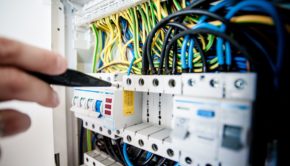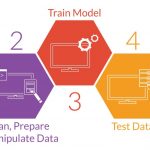The Tech Behind Electricity: A Closer Look At What Powers Device
Ever wondered what beyond the magic of light illuminating your room when you flip a switch? Or how your smartphone survives a whole day with one charge? This curiosity marks the start of this journey to explore the technology behind electricity, and how it powers numerous devices in people’s daily lives. Ready to dive into this electrifying exploration? Then keep moving!

History of Electricity
Long before electricity’s integral role energizing modern life, lightning’s dazzling yet violent bursts during storms captured early humans’ imagination and awe of this mysterious natural force. While its principles went unexplored for centuries, seeds were sown for eventually mastering electricity to propel societal evolution.
Experimentation by innovative pioneers like Benjamin Franklin and Alessandro Volta unlocked electricity’s potential by reproducing it on small scales. Volta’s battery enabled portable storage and controlled electrical flow for the first time.
Meanwhile, Thomas Edison’s light bulb harnessed electricity to safely illuminate indoor spaces, supplanting open flames. This groundbreaking innovation heralded reliable access to artificial light without fire’s hazards – a seminal advancement catalyzing waves of electrical technologies proliferating into all facets of industry and daily life over the next century.
Step by step, these foundational breakthroughs unleashed electricity’s latent power, progressing civilization toward today’s electrified modern world empowered by the dedicated researchers determined to probe Nature’s secrets and channel its forces to benefit humanity.
Concept of Voltage
Grasping what voltage is, is necessary to understanding how devices work. Voltage refers to the electrical pressure that drives current through circuits and components. Imagine voltage like the water pressure flowing through plumbing pipes. The stronger the pressure, the higher the water flow.
Similarly, devices require a certain minimum voltage to operate properly, much like cars need adequate fuel pressure for peak performance. The required voltage essentially determines whether an appliance can simply plug into a wall outlet or will need a heavy-duty power source.
Roles of Circuit Components
A device’s circuit board is akin to a miniature city, with roads (traces) leading to various buildings (components). Each of these components performs a specific task, much like different city departments. Resistors control current flow, capacitors store electrical energy, and semiconductors enable or hinder electricity flow — each tuning the circuit for optimal operation.
Microprocessors, the superintendents of this electrical city, coordinate this interplay to execute functions from web browsing on your smartphone to making bread in your toaster. Services like here, https://www.thelocalelectrician.com.au/level-2-electrician/north-shore/, understand the complexities of these electrical components and how they power homes.
The Power Source’s Purpose
Every electric system needs a power source to function. Its primary purpose is to convert alternate forms of energy into electrical energy that devices can utilize. For example, a car battery changes chemical energy into electricity, while a generator transforms mechanical energy into electrical power.
This intrinsic element is also responsible for maintaining the designated voltage level. You can think of it as the heart of any electronic device, providing vital electricity necessary for operation.
Pathways of Circuits
The layman often thinks an electrical circuit is simply a loop wire connecting devices or components. While true at its core, understanding the pathway for tiny charged particles (electrons) enriches this concept. People have series circuits where current travels along one path only, parallel circuits offering multiple paths, and complex circuits which are combinations thereof.
Your home is likely full of parallel circuits — hence why your refrigerator maintains its chill even if you switch off another appliance. However, that series string of Christmas lights might have created confusion when one faulty bulb caused the whole strand to go out!
Nature of Electrical Load
In an electrical context, load signifies anything consuming power. It could vary from household appliances like a toaster or refrigerator to industrial machinery. Essentially, these devices convert electrical energy into other forms — light, heat, or mechanical energy.
Understanding this will put into perspective the immense power requirement of industrial cities or densely populated urban areas. However, this load must be managed effectively to ensure the availability and sustainable use of power resources.
Professionals such as The Local Electrician understand fully how to safely incorporate this power safely into commercial and residential properties.
Switch Operations
A switch is a technically straightforward yet magnificent invention that controls electricity flow in circuits. Simply put, flipping a switch connects (on) or disconnects (off) an electrical circuit. Regardless of its banality in your day-to-day life, this control mechanism is truly empowering.
From turning on a light bulb to firing up an aircraft’s turbine engine, switches are the gateway to activating electrical devices. Even digital devices such as smartphones have internal switches in their circuitry responsible for executing instructions processed by their operating software.
Understanding Power Grids
The power grid refers to the vast interconnected transmission infrastructure that delivers electricity from generators at power plants to end users in homes and businesses.
This complex web of high-voltage towers and cables, substations, and transformers must coordinate to transmit massive amounts of power over long distances essentially instantaneously to keep modern life running. Flipping a light switch draws electricity from this grid whose reach and instant responsiveness makes it a marvel of modern engineering.
The Transition to Digital Tech
The rise of digital electronics and the Internet of Things (IoT) has transformed electrical systems by enabling smart devices and infrastructure. Modern power meters now incorporate digital sensors and connectivity for automated, real-time energy monitoring and optimization by both utilities and consumers.
By providing insights into usage patterns and infrastructure demands, this digital shift allows for more efficient, responsive power management across smart grids and devices.
Sustainable Energy Sources
There is an obvious shift towards sustainable energy sources. Given environmental challenges and limited availability of fossil fuels, renewable sources like wind, solar and hydroelectric have gained prominence.
Beyond being sustainable, these resources present less operational hazards while offering opportunities for decentralizing energy production – think rooftop solar panels. The future holds promise with other technologies emerging like tidal-energy or even space-based solar panels.
Importance of Energy Storage
While generating electricity is vital, so is the ability to store excess energy for later use or when generation isn’t possible. Common solutions are batteries – from Lead-acid ones in your cars to Lithium-ion ones in your electronics.
However, on a grand scale energy storage plays an important role in managing grid stability. Advancements in technology are seeing newer, safer, and more efficient storage options like flow batteries or liquid air energy storage which have potential to revolutionize the energy sector altogether.
Ongoing Research
Emerging fields like Quantum Computing and Nano Technology might redefine how humans use power. For instance, Quantum computers could process complex computations at exponentially higher speeds than classical systems. This processing efficiency may reduce heavy power demands associated with traditional supercomputing.
On the other hand, advances in nanotechnology offer possibilities of more efficient solar cells, ultra-capacitors for energy storage, and even energy-harvesting textiles. Such innovation continues to reshape your understanding and manipulation of electricity.
In Closing
Given the degree to which high-tech modern civilization relies on ready access to vast amounts of electricity, gaining insight on the infrastructure underpinning reliable power offers a fascinating perspective.
As sustainable generation expands and nanoscale breakthroughs unlock greater efficiency, the future shines brightly. Perhaps after reading this, you’ll take a moment to appreciate the deeper story behind simply flipping on a light switch thanks to the local electrician and other unsung heroes working hard behind the scenes!
















